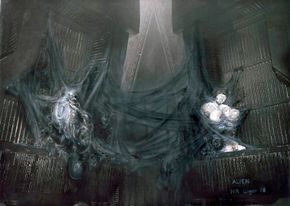The Xenomorph Cocoon
The genetic mandate of any organism is propagation. It must spread its genes, and eons of evolution have populated Earth with myriad strange and complex life cycles.
Asexual creatures produce offspring that are essentially genetic clones of themselves, while sexual reproduction involves the combination of genes from two organisms. Some creatures can even reproduce both ways. Complex life cycles and social structures build up around these reproductive methods, leading to everything from intricate honeybee hives to the complex, 13-stage, two-pronged life cycle of the Micromalthus debilis wood beetle [source: Taylor].
Advertisement
The xenomorph life cycle clearly begins with an egg, but just where does that egg come from? The lone alien encountered aboard the Nostromo apprehended two living crew members and cocooned them in a nest of secreted resin. According to some accounts of the Nostromo incident, Warrant Officer Ellen Ripley found both crew members in a state of metamorphosis. By all appearances, they were transforming into xenomorph eggs.
The Nostromo incident seems to suggest a very strange form of reproduction, in which a xenomorph plants an initial parasitic proto-embryo inside a host, which then virally and totally transforms the host's body into a facehugger-gestating egg.
This life cycle would look like this:
proto-embryo → cocoon egg → facehugger → embryo → chestburster → adult
The notion isn't as far-fetched as it sounds, as various terrestrial parasites alter host behavior or physiology. Worms in the Leucochloridium genus, for instance, grow a colorful, pulsating broodsac up through a host snail's eyestalk and force the zombified creature to lure in predatory birds -- all so the parasite can continue its multihost life cycle.
Of course, not every account of the incident mentions the cocoon, and the subsequent events at the LV-426 terraforming colony revealed a far more traditional means of egg production.
